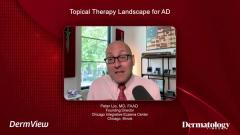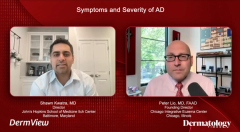
Topical Therapy Landscape for AD
Experts discuss the history and evolving landscape of topical steroids as therapy for atopic dermatitis (AD).
Episodes in this series

Transcript
Shawn Kwatra, MD: If someone comes to see you and you know they have some pretty active and hot areas, maybe the elbows in the antecubital fossa, or in the legs. Before you pick something, are there some more questions you ask, or what are you leaning toward? What are some of the options you think about?
Peter Lio, MD, FAAD: We're lucky that in the past particularly 5 years, but even in my career over the past 20 years, we've seen a bunch of new options. One of my teachers who passed away just in the last couple of years, Sam Moschella [Samuel Moschella, MD], was practicing, before compound F was widely available, before hydrocortisone. We would say, "Dr Moschella, how was it practicing dermatology without any topical steroids at all?" He's like, “It's really tough." We just didn't have anything. It's so crazy to think about that. Now, of course, we have our topical steroid revolutions. During the 1950s, it was sort of developed and then, of course, increasingly sophisticated many, many different variations. Then, the next big entry into this whole story happened around the year 2000 with tacrolimus. Just a year later, it was pimecrolimus. Those 2 topical calcineurin inhibitors gave us our first nonsteroidal agent for atopic dermatitis and they were pretty awesome. They still are pretty awesome until around 2005, when the FDA put the black box warning on things, and that kind of had a chilling effect on those, but they still persist and they're wonderful. Then, it wasn't until 2016 that we got crisaborole, our first new big one in a while, the phosphodiesterase, for an inhibitor out of an anti-inflammatory and I'm grateful for it. I know that it's had maybe some mixed reviews, it's maybe not as powerful as we wish. Certainly, the stinging and burning was more common, I think, than it seemed to be from the pivotal trials, but still a useful adjunct. More recently, we finally have a new entry, which is our first topical JAK inhibitor. That's pretty exciting, with ruxolitinib and what's exciting about [ruxolitinib] is that, in particular, it's, in my opinion, the most powerful nonsteroidal we've seen. It's very difficult to compare across trials and across things, but just my clinical experience, is that just the speed that it works and the sort of the equivalency of potency when we see that clinical effect because obviously, it's not steroid. We measure steroid potency with the Stoughton scale to see the vasoconstrictive, this doesn't have that. The clinical effect puts it on par. In my experience with… about a midpotency topical corticosteroid, which is pretty neat to have that, I still think topical steroids. I have a tremendous amount of respect for them. In fact, maybe I'm more gun-shy about topical stories than almost any of our colleagues because I have a group of patients that has this topical steroid withdrawal that is very complex and nuanced; it is probably not 1 thing, and it's tricky to navigate. We're working on a few things right now. We've been talking to about how we can understand this better. How can we get the word out? Because of that, I'm extra careful. Even despite that though, topical corticosteroids tend to be our first-line because they're super reliable. Almost 100% of patients we put them on are going to have some effect; they're going to show improvement. Number 2, they're extremely accessible. You can't beat free, or a $4 copay. Truly, they are safe when they're used correctly. We have 50, 60, 70, and going on 70 because of data with these things. It's incredible, right? I really like the fact that we know a lot about them. That's often where I'll start: how do you view this sort of landscape of our topical therapies?
Shawn Kwatra, MD: You know, I have a similar impression to you, in that topical steroids have for a long time been the mainstay also because access to amounts of medication like a jar of triamcinolone 400 gross grams. You can get for someone who has more extensive disease. That's a really helpful tool for us. I would agree with you that, in all the different strengths, it has been helpful.
Transcript edited for clarity.
Newsletter
Like what you’re reading? Subscribe to Dermatology Times for weekly updates on therapies, innovations, and real-world practice tips.


























